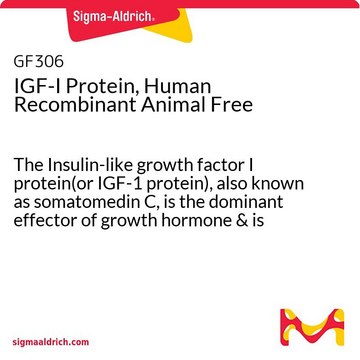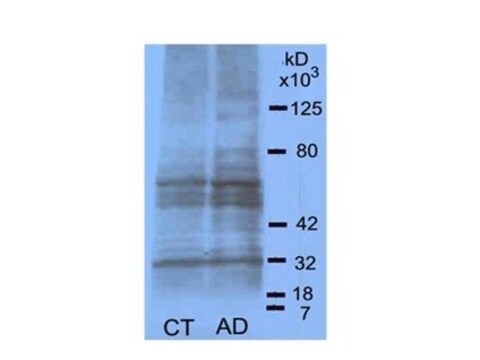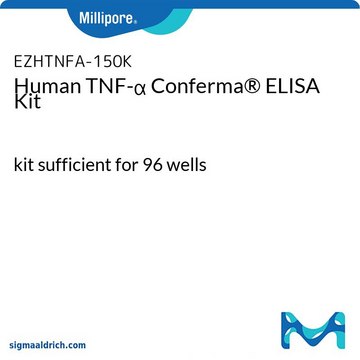RAB0601
Human FGF1 / Fibroblast Growth Factor 1 ELISA Kit
for serum, plasma, cell culture supernatants and urine
Iniciar sesiónpara Ver la Fijación de precios por contrato y de la organización
About This Item
UNSPSC Code:
41116158
NACRES:
NA.32
Productos recomendados
species reactivity
human
packaging
kit of 96 wells (12 strips x 8 wells)
technique(s)
ELISA: suitable
input
sample type urine
sample type cell culture supernatant(s)
sample type plasma
sample type serum
assay range
inter-assay cv: <12%
intra-assay cv: <10%
sensitivity: 12 pg/mL
standard curve range: 16.38-4000 pg/mL
detection method
colorimetric
shipped in
wet ice
storage temp.
−20°C
Gene Information
human ... FGF1(2246)
General description
FGF1 (fibroblast growth factor 1) gene encodes a member of the fibroblast growth factor (FGF) family. It encodes a pro-angiogenic protein that is ubiquitously expressed. In humans, FGF1 is alternatively spliced into four forms: FGF1A (in kidney), FGF1B (in brain), FGF1-C and -D (in vascular smooth muscle cells and fibroblasts). This gene is located on human chromosome 5q31.
Application
For research use only. Not for use in diagnostic procedures.
Please refer to the attached General ELISA KIT Procedure (sandwich, competitive & Indirect ELISA)
Please refer to the attached General ELISA KIT Procedure (sandwich, competitive & Indirect ELISA)
Biochem/physiol Actions
FGF1 (fibroblast growth factor 1) is mainly involved in cell growth, proliferation and neurogenesis. It also participates in wound healing, post-ischemic heart repair and making of collaterals after hindlimb ischemia. FGF1 functions as an angiogenic factor that participates in tissue repair, carcinogenesis and maintenance of vasculature stability.
The FGF1 ELISA kit provides for the quantitative measurement of Fibroblast Growth Factor 1 in Cell Culture Supernatants, Plasma and Serum.
Other Notes
A sample Certificate of Analysis is available for this product.
Please type the word sample in the text box provided for lot number.
Please type the word sample in the text box provided for lot number.
signalword
Warning
hcodes
pcodes
Hazard Classifications
Met. Corr. 1
Storage Class
8A - Combustible corrosive hazardous materials
flash_point_f
Not applicable
flash_point_c
Not applicable
Elija entre una de las versiones más recientes:
¿Ya tiene este producto?
Encuentre la documentación para los productos que ha comprado recientemente en la Biblioteca de documentos.
Daniel Chiumia et al.
International journal of molecular sciences, 21(5) (2020-03-01)
Fibroblast growth factors (FGF) play an important role during embryo development. To date, the role of FGF and the respective receptors (FGFR) during the preimplantation phase in cattle are not fully characterized. We examined FGF1, FGF2, FGFR1, FGFR2, and FGFR3
Jun Chen et al.
Experimental and therapeutic medicine, 18(2), 1005-1012 (2019-07-19)
Recently, microRNA (miR)-628 was identified as a potential biomarker for several types of cancer, including prostate cancer (PCa). The aim of the present study was to investigate miR-628 expression and its underlying mechanism in PCa cell proliferation and invasion and
Hongyu Guan et al.
Cell & bioscience, 8, 26-26 (2018-04-11)
Innate immunity activator (INAVA) has been shown to be elevated in lung adenocarcinoma. However, its expression pattern and function in papillary thyroid cancer (PTC) are unknown. This study aimed to identify the clinical, biological, and mechanistic impacts of INAVA on
Transgenic expression of nonclassically secreted FGF suppresses kidney repair.
Kirov A, et al.
PLoS ONE, 7(5), e36485-e36485 (2012)
Fibroblast growth factors.
Ornitz DM and Itoh N
Genome Biology, 2(3) (2001)
Nuestro equipo de científicos tiene experiencia en todas las áreas de investigación: Ciencias de la vida, Ciencia de los materiales, Síntesis química, Cromatografía, Analítica y muchas otras.
Póngase en contacto con el Servicio técnico









